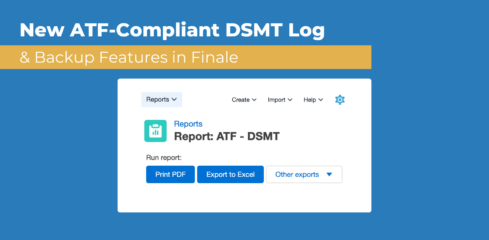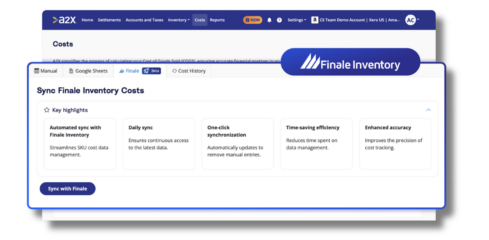Amazon Inventory Management: 5 Tips on How to Tackle Disorder for Efficiency
Have you ever thought about the size of Amazon’s inventory? As the world’s largest online retailer and most dominant online marketplace, you can bet that their warehouses are stocked to the brim with all sorts of products. In fact, when you think of all the items Amazon has stored and readily available for sale and shipment, the might and complexity of their inventory become even more impressive.
For businesses, though, Amazon’s expansive inventory and their solid management should raise an important question: how do they tackle such a large inventory and keep things running efficiently? This is an especially poignant question if you are selling products through Amazon. As an Amazon vendor, you have an Amazon inventory of your own to handle.
It’s no secret that the larger a business’ inventory is, the more complex it becomes to manage and organize it well. However, if Amazon seems to have cracked the code for success, you can too. Taking our cues from Amazon inventory management, we’ll now discuss five tips on tackling Amazon order management.
Understanding Chaotic Storage
We know the term chaotic storage probably evokes some stress and anxiety. You may think the current state of your warehouse is chaotic, meaning things aren’t that organized or managed well. However, despite its name, chaotic storage is actually a system used by Amazon and other large businesses to manage their storage facilities efficiently.
Thanks to automated inventory and warehouse management systems and software, chaotic storage depends on technology like barcodes and barcode scanners. With chaotic storage, incoming products are placed randomly in the warehouse on available shelf space without worrying about itemized locations or strategies. While it sounds like madness, this method actually increases warehouse efficiency and streamlines the inventory processes. Chaotic storage only works when you have a management software system in place. Otherwise, you’re not usefully storing your inventory.
The software accurately aggregates information about particular items and their locations within the warehouse using barcodes and barcode scanners. Users can print barcodes for certain products and use them to track and organize inventory across single or multiple warehouses. When you run your warehouse with inventory management software, you can appoint locations within the warehouse through barcoding.
You can also create a type of barcode known as stock keeping units, or SKUs, to identify specific products within the warehouse because SKUs are scanned into different locations throughout your warehouses. This simple addition makes it easy to find and track what you’re looking for, no matter where it is.
5 Tips to Tackle Disorder for Efficiency
Now that you know about chaotic storage and how it works, let’s review five tips to tackle Amazon inventory management. With them, you can navigate disorder for efficiency every time, whether you’re drop shipping on Amazon or using it to sell your own products.
1. Use a Cloud-Based Inventory Management Software
Number one on our tip list is implementing cloud-based inventory management software. It may seem surprising, but many sellers and businesses still keep track of their inventory with spreadsheets and programs like Excel. While this may work for smaller companies with smaller stocks, your business should switch to a better inventory management solution for the long run. Spreadsheets can be inaccurate or become lost or damaged. Overall, they’re an inefficient option.
On the other hand, software allows you to keep track of inventory in more ways than one. Software systems are accurate, help automate different aspects of inventory management like ordering, provide real-time analytics, and keep everything saved and accessible through multiple channels and access points. If you sell on Amazon, various tools help you manage all inventories that integrate with Amazon.
Inventory management software also makes tracking products, interacting with customers, and managing shipments and returns easier than ever. This leads to excellent customer relationships and encounters with your unique store.
2. Utilize Real-Time Analytics
Staying up to date with what’s happening with your business is another excellent way to tackle disorder and increase efficiency. A large entity like Amazon is certainly always staying up to date on inventory, selling performance and other analytics to provide customers with the most accurate feedback. You’ll also want to regularly analyze the data to maximize productivity and profit.
Using real-time analytics immediately improves inventory management because it helps you gauge your stock’s selling performance. Too much or too little stock can result in higher costs over time and cause a negative customer experience. With real-time analytics, you never have to worry about being over- or under-stocked because you’ll always know your inventory numbers in real-time, all the time.
When you use real-time analytics, you also be able to review the following:
- Tracking Referral Traffic: Reviewing your referral traffic will help you know where your marketing campaigns are working, where you need to take it up a notch and where to reassess.
- Monitoring Revenue Goals: Stay current with revenue targets to know how your sales goals are going at all times. Whether a product is hurting or helping your goals, analytics keeps you in the loop.
- Identifying Trends: Monitor customer behavior so that you can determine which products are in the highest demand. You can then take advantage of this information and work to meet customer needs before they arise.
3. Plan Ahead
Analytics can help you plan ahead. Knowing what’s happening with your inventory, customers, and market trends gives you a leg-up to prepare for the future. By monitoring analytics, going over sales records and information, watching trends and studying customer behavior, you can identify patterns to forecast coming trends.
In addition to sales information and customer behavior, you should pay attention to the following to plan ahead:
- Customer and supplier feedback: Feedback from your customers and suppliers is instrumental in helping you plan and grow your business. Listening to customers and your supplier will help you know what’s going on with your inventory and market trends to forecast future patterns in inventory trends.
- Supply chain lead time: Your inventory’s supply chain lead time will differ depending on whether you work with a supplier or manufacture your own products. You’ll need to understand how long the product production process takes, from manufacture time to the time it takes them to arrive at Amazon. Be sure you know the delivery dates and conditions of delivery, as well.
- Inventory turn rate: You’ll also want to know your Amazon inventory turnover rate to understand the amount of inventory you need to maintain stock levels between shipments. Understanding your supply chain lead time and inventory turn rate can help you manage your inventory to keep a good in-stock rate.
- Seasonality: Consider how seasonality impacts your inventory. Is a specific product in higher demand during a particular time of the year? Knowing how your inventory changes during specific times of the year can help you determine where there could be potential sales slowdowns and better manage your stock.
Planning ahead can make your business and inventory management much more efficient. You’ll know what shipments and products require your immediate attention, monitor cost, predict estimated profit, and stay up to date on all shipments as they come and go.
4. Monitor Suppliers
Excellent business relies in part on an excellent relationship between the seller and supplier. Of course, a lot goes into strengthening this relationship. You have to monitor for certain issues to identify when a supplier relationship isn’t working. For example, some suppliers won’t stick to drawn-up schedules or deliver inventory on time, which can throw a wrench in how you manage inventory and ultimately decrease customer satisfaction.
Keep an eye out for the following in case you run into problems:
- Estimated or promised dates for delivery
- The dates deliveries are actually received
- Quantity order and received
- The package’s condition when it arrives
If you find that your seller is unreliable, you might have to address the issues immediately in hopes of improved service or cut ties. To make things run even smoother, you may want to switch to automated product fulfillment through a known reliable source such as Amazon FBA. You already know that Amazon inventory management is solid, so switching to work with a known reliable source is a smart course of action.
5. Learn About Amazon’s Inventory Performance Index
Amazon’s Inventory Performance Index, or IPI, is a metric Amazon uses for ASINs to assess sellers’ inventory management. If you need to manage inventory on Amazon, it’s crucial to understand how Amazon assesses inventory turnover and warehouse management. FBA has limited space for inventory, so Amazon set up its IPI in July 2018 to ensure inventory moves quickly enough, so there’s enough space for in-demand items.
Amazon sets a target score each quarter based on the amount of storage they anticipate needing, and scores range from zero to 1,000. Sellers who fail to make a specific IPI score during a quarter face FBA fines and decreased inventory storage space. Further, properly managing your Amazon inventory helps you maximize profits and keep customers satisfied.
Sellers attempting to make a particular IPI score have to consider components of inventory management:
- Sell-through rate: The sell-through rate measures your inventory management against your sales. You calculate the sell-through rate by dividing the total number of units you’ve sold in 90 days by the number of units in FBA during the same period. If you want to improve your sell-through rate, improve listing traffic and maintain sufficient inventory to fulfill demand. A low sell-through rate might indicate you may have ordered too much stock.
- Excess inventory: Because holding an excess of inventory can contribute to additional fees and take up valuable space, Amazon wants to ensure sellers are properly managing their inventory. Excess inventory is the top reason why sellers have a low IPI score. To calculate excess inventory, divide the number of excess FBA inventory units by the total number of FBA units. To eliminate excess inventory, advertise a sale to customers and offer price matching.
- In-stock rate: The in-stock rate is the percentage of the last 30 days ASINs were in stock weighted by the number of units sold over 60 days for each SKU. Managing your in-stock rate can help you properly maintain both sales and inventory levels.
- Stranded inventory: The number of FBA inventory units unavailable for purchase. Issues like pricing and listing errors, expired ASINs or deleted listings could cause stranded inventory. You can calculate stranded inventory by dividing the number of unavailable FBA units by the total number of FBA units.
Amazon Warehouse Management Systems With Finale Inventory
When it comes to inventory management, there are a few tried and true ways to know you are doing the best you can. Choosing the best cloud-based inventory management software, looking to established and reliable sources like Amazon, and keeping an eye on customer satisfaction are just some of the valuable ways to tackle disorder for efficiency.
When your business is running smoothly, you can expect good revenue and continued growth in the future. With the help of Amazon and Finale Inventory, there’s no telling how far your business can go. Schedule a live product demo or register for your free two-week trial with Finale Inventory today!





